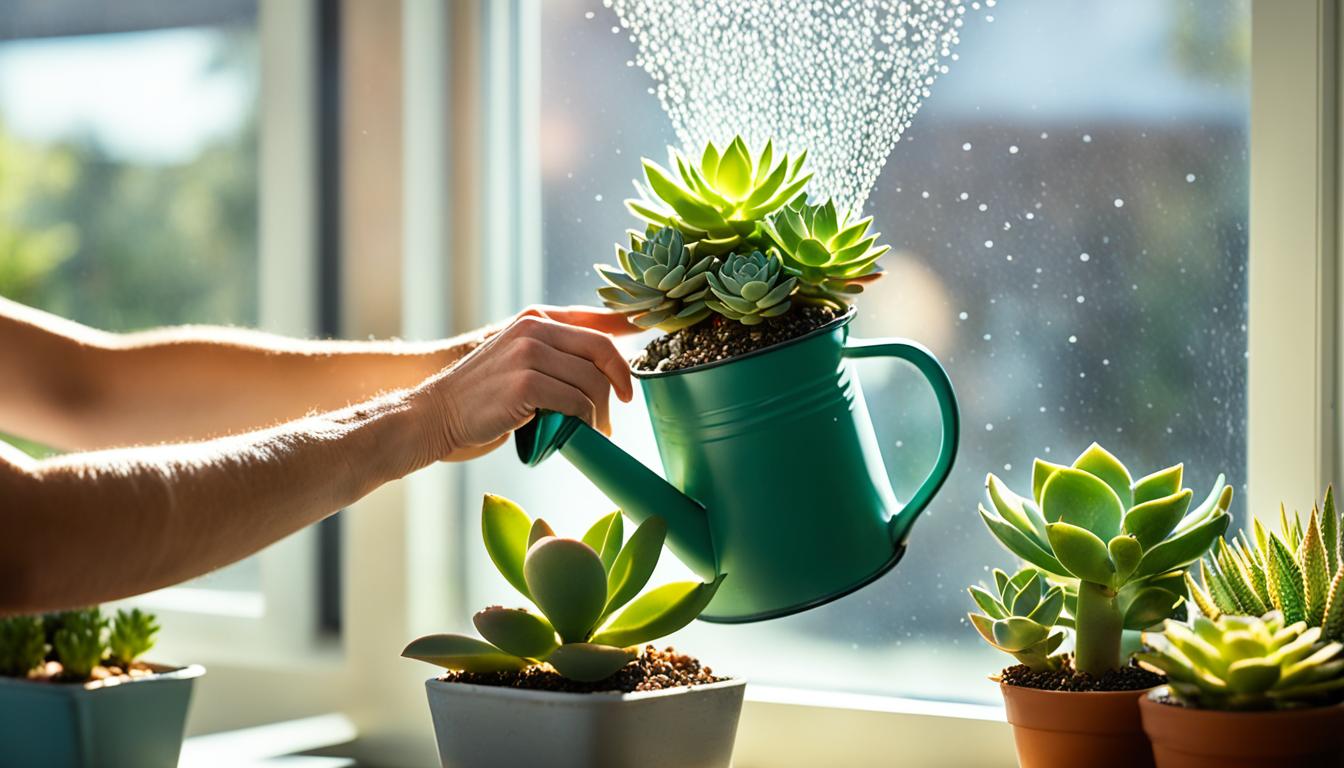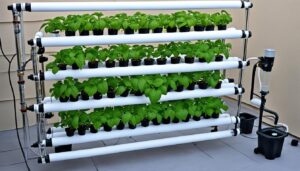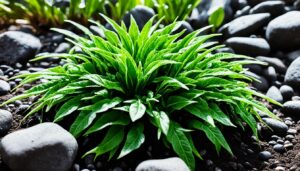Are your indoor succulents not doing well, and you’re not sure why? Many people struggle to get the watering right for their indoor succulents. This guide will give you the knowledge and tips to keep your succulents healthy indoors.
Experts say the secret to keeping succulents alive indoors is knowing how much water they need. Overwatering is often the main reason succulents die, but underwatering can also cause problems. By learning the best way to water your indoor succulents, you can prevent these issues and have beautiful plants all year.
Key Takeaways
- Understand the unique watering needs of indoor succulents to prevent overwatering or underwatering.
- Establish a consistent watering routine based on the soil dryness, not a set schedule.
- Learn to identify the signs of over and underwatering to make adjustments to your watering practices.
- Ensure your succulents are planted in well-draining soil and containers with proper drainage.
- Adjust your watering approach for succulents in low-light conditions to avoid issues.
Introduction
Caring for succulents indoors can be rewarding if you know what they need. These plants are often seen as easy to care for, but they have their own set of needs. To keep your indoor succulents healthy, you need to learn how to water, light, and care for them right.
This guide will help you understand succulent care for indoor plants. We’ll talk about the best watering schedule and how to avoid mistakes that can harm your succulents. By the end, you’ll know how to keep your indoor succulents thriving.
Whether you’re new to plants or love succulents, this guide has what you need to become a pro at indoor succulent care. We’ll cover everything from their unique watering needs to creating the best environment for them. You’ll learn how to keep succulents alive indoors and enjoy their beauty.
“Succulents are a fantastic choice for indoor gardening, but they require a slightly different approach than traditional houseplants. With the right care and attention, you can enjoy the beauty and low-maintenance of these resilient plants in your own home.
Understanding Indoor Succulent Watering Needs
Succulents are known for surviving in dry places by storing water in their leaves and stems. This lets them last through dry spells. But, they need a special watering routine indoors.
Indoor succulents don’t get rain like outdoor ones do. They count on you to water them right. Too much water can cause root rot, while too little makes them dry and lose color.
Adapting to Indoor Conditions
Indoor succulents have different watering needs than those in the wild. Here are some things to think about:
- Light Exposure: Indoor succulents get less sunlight than outdoor ones, which changes their water needs.
- Soil Composition: The soil that’s good for succulents outdoors can hold more moisture indoors.
- Temperature and Humidity: The indoor climate can make succulents use and lose water at different rates.
Keep these points in mind to create a watering plan that suits your indoor succulents. This way, they can thrive indoors.
“The key to successful indoor succulent care is understanding their natural habitat and adapting your watering practices accordingly.”
Best Practices for Watering Succulents Indoors
When watering best way to water succulents indoors, remember a few key tips. Always pour water on the soil, not the leaves, to avoid water spots and rot. Also, make sure to throw away any extra water that collects in the saucer. This keeps the roots from sitting in moisture.
Don’t use spray bottles to water your indoor succulents. This can cause fungal growth and pests. Instead, the “soak and dry” method is the best way to avoid overwatering succulents. Soak the soil well, then let it dry out fully before watering again.
- Pour water directly onto the soil, not the leaves
- Discard any excess water that drains into the saucer
- Avoid using spray bottles to water succulents
- Utilize the “soak and dry” method for optimal watering
By following these best practices, you can keep your indoor succulents healthy. The key is to watch the soil moisture and adjust your watering as needed. This way, you’ll give them the right amount of water without overdoing it.
How to Create an Indoor Succulent Watering Schedule
Keeping a consistent watering schedule is key for your indoor succulents’ health. Follow these steps to make a watering schedule that fits their needs.
First, understand what indoor succulents need. They usually need less water because they get less light and air inside. Water them when the soil is dry a few inches down in the pot.
How often you water depends on the climate, temperature, and type of succulent. In summer, water them once a week. In fall and winter, you might only need to water every other week. Watch your plants and adjust the schedule as needed.
To make a good watering schedule, follow these steps:
- Inspect the soil: Check the soil moisture by sticking your finger into the pot. If the soil feels dry a few inches down, it’s time to water.
- Establish a routine: Set a regular watering day, such as every Sunday or every other Wednesday, to help you remember to check and water your succulents.
- Adjust for seasonal changes: Reduce watering frequency during the fall and winter when succulents are in their dormant phase and require less moisture.
- Pay attention to individual needs: Some succulent species may have slightly different watering requirements, so be sure to research the specific needs of the plants in your collection.
By sticking to a consistent watering schedule, you can make sure your plants get the right moisture. This prevents overwatering and underwatering, helping them thrive indoors.
Remember, the secret to a healthy indoor succulent garden is finding the right balance. With a little trial and error, you’ll find the perfect watering schedule for your plants.
Signs You’re Overwatering or Underwatering Your Succulents
Caring for indoor succulents is a delicate task. It’s important to know the signs of over or underwatering. This knowledge helps avoid mistakes and keeps your plants healthy. Whether you’re new to succulents or have been growing them for years, these signs are key.
Underwatering Succulents
Underwatered succulents show these signs:
- Wrinkled, shriveled, or bendy leaves that appear crispy or dry
- The plant appears smaller than usual or stunted in growth
- The soil becomes extremely dry and difficult to penetrate
It’s usually easier to spot and fix underwatering. If you’re unsure, it’s best to give your succulents a bit more water.
Overwatering Succulents
Overwatering can harm your indoor succulents a lot. Watch for these signs:
- Leaves that appear mushy, squishy, or discolored (often turning yellow or brown)
- Stems that are soft, weak, or rotting
- The soil remains constantly wet or soggy
Overwatering is a common mistake with indoor succulents. Pay attention to these signs and adjust your watering.
Knowing the signs of over and underwatering helps you give your succulents the right amount of water. This way, they’ll stay healthy and happy for a long time.
Watering Tips for Succulents in Low Light Conditions
Caring for succulents in low light can be tricky, but you can keep them thriving with the right approach. Knowing how to water succulents in low light environments is key.
Newly planted succulents are sensitive to direct sunlight and need a gradual introduction to full sun. During this time, shade with a sheer curtain or indirect light can prevent burning.
Succulents usually need about 6 hours of sun per day, depending on the type. In low light, adjust your watering to prevent overwatering. This can cause root rot and other problems. Here are tips to keep your indoor succulents alive and healthy:
- Water less often: Succulents in low light need less water than those in bright sun. Check the soil and water only when it’s dry.
- Use the “soak and dry” method: Soak the soil when you water, then let it dry out completely before watering again.
- Adjust watering based on the season: Succulents need less water in winter when they grow less.
- Ensure proper drainage: Plant your succulents in well-draining soil and a pot with good drainage holes to prevent waterlogging.
By following these watering tips for succulents in low light, you can help your plants thrive. This way, you avoid common problems like overwatering or underwatering.
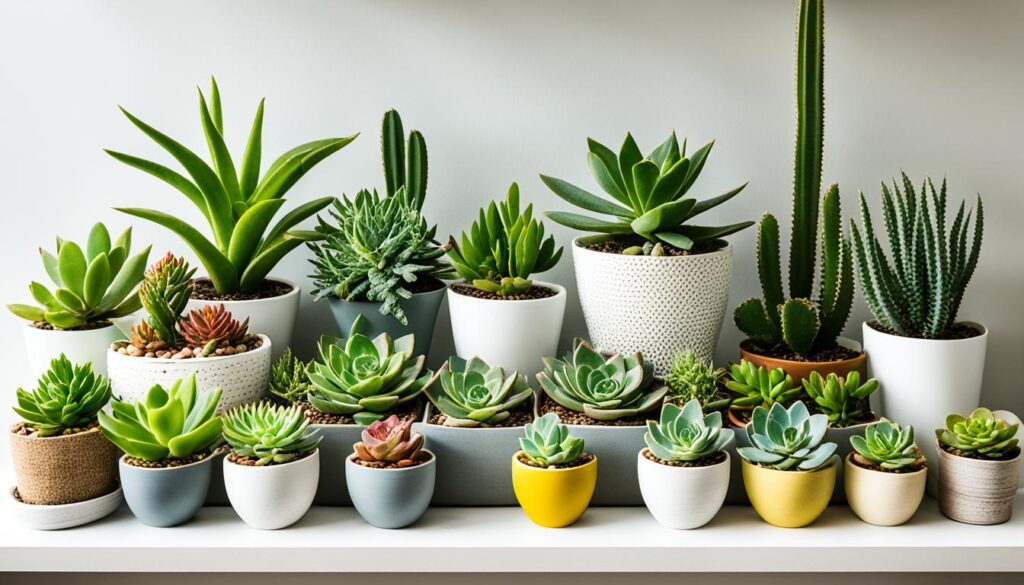
How to Avoid Common Watering Mistakes with Indoor Succulents
Caring for indoor succulents requires a delicate touch. One big mistake is overwatering, which can cause root rot and diseases. To keep your succulents healthy, avoid these common succulent watering mistakes indoor.
Don’t use a spray bottle to water your succulents. They’re not like other houseplants and don’t like water on their leaves. This can cause moisture to stay on the leaves, leading to fungal diseases. Water them at the soil level, letting the soil dry out fully before the next watering.
- Avoid using a spray bottle to water indoor succulents
- Water succulents directly at the soil level, not on the leaves
- Allow the soil to dry out completely between waterings to prevent overwatering succulents
Don’t let your succulent’s roots sit in too much water after watering. Make sure to pour off any excess water. This can cause root rot and kill your indoor succulents.
“The key to healthy indoor succulents is patience and restraint when it comes to watering. Less is more with these drought-tolerant plants.”
By avoiding these watering mistakes, you can keep your indoor succulents looking great for years.
The Importance of Using the Right Soil and Pot
For healthy indoor succulents, start with the best way to water succulents indoors. Use fast-draining, gritty soil mix made for succulents or cacti. Regular potting soil holds too much moisture, which can cause root rot.
Terra-cotta pots are great for how to avoid overwatering succulents. They let excess moisture escape, preventing soil from staying too wet. Plastic or glazed pots, on the other hand, can trap moisture and cause overwatering.
- Use a well-draining, gritty soil mix for your indoor succulents
- Terra-cotta pots are best as they help prevent overwatering
- Avoid regular potting soil, which holds too much moisture
Choosing the right soil and pot is key to your indoor succulents’ health and long life. By creating the perfect environment, you can prevent overwatering and help your plants thrive.
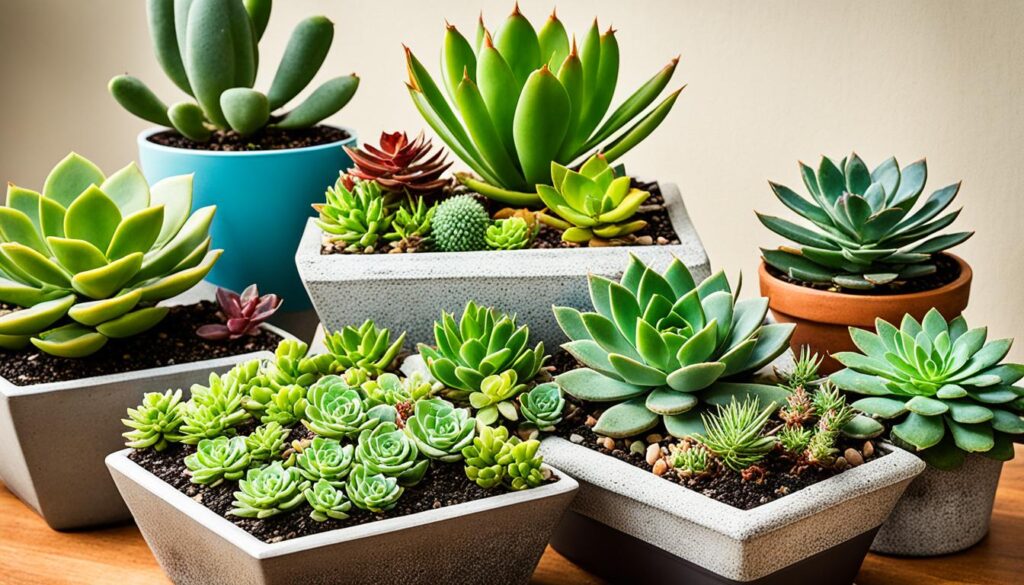
“The soil and pot are the foundation for healthy, vibrant indoor succulents. Neglecting these essentials can lead to a host of problems down the line.”
Setting up your indoor succulents for success is the best way to water succulents indoors and how to avoid overwatering succulents. With the right soil and pot, you’re on your way to a thriving, easy-to-maintain succulent oasis at home.
Final Tips for Keeping Your Indoor Succulents Healthy
To keep your indoor succulents healthy, make sure to rotate them regularly. This ensures they get even light, preventing them from growing lopsided. Succulents are easy to care for but need the right conditions to flourish.
Follow the main tips from this guide: use well-draining soil, water carefully to avoid overwatering, and consider the specific needs of your plants. By doing so, you’ll keep your succulents thriving and enjoy their beauty for many years.
With proper light, water, and care, your indoor succulents will have vibrant leaves and add peace to your home. Enjoy the simple pleasure of caring for these beautiful plants. Let them add a touch of nature to your life.
Source Links
- https://www.architecturaldigest.com/story/how-to-care-for-succulents – How to Care for Succulents (And Not Kill Them): 9 Plant Care Tips
- https://www.thespruce.com/how-to-water-succulents-6828113 – How to Water Succulents
- https://natalielinda.com/how-to-water-succulents/ – How to Water Succulents – the Right Way


